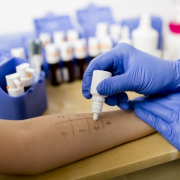Contents |
Introduction
Contact dermatitis is a relatively common skin inflammation caused by direct contact with an irritating substance. There are two different types, known as primary irritant contact dermatitis and allergic contact dermatitis.
Nearly everyone has some form of allergy or sensitivity to specific things, but we usually only discover what they are only after being exposed to it and suffering the ill effects. The eyelids and the conjunctiva (the transparent skin covering the white of the eye and lining the insides of the lid) are particularly susceptible to contact dermatitis because they are constantly being exposed to irritants through rubbing or otherwise touching. These tissues are also prone to swelling, because they are thin, loose and have a rich blood supply.
Symptoms
The symptoms and treatment of the two types of contact dermatologists are similar, and include skin redness, swelling, itching, burning and scaling.
Irritant contact dermatitis occurs when a chemical substance causes direct damage to the skin. Typical irritants are acids, alkalis (like drain cleaners), solvents (like acetone in nail polish remover) and strong soaps. Some of these chemicals cause skin changes within a few minutes, but others may require a longer exposure; also, people vary greatly in the sensitivity of their skin to irritants. Even very mild soaps and detergents may irritate the skin of some, especially after frequent or prolonged contact.
Allergic contact dermatitis is a reaction of the body’s immune system to a substance after at least one previous exposure to sensitize the skin. Some people can be sensitized by only one exposure while in other cases it may take many exposures. Once a person has been sensitized, the next exposure will cause symptoms within four to 24 hours, although some people, particularly older people, do not develop a reaction for several days, which makes it difficult to determine exactly what it was that caused it.
Thousands of substances may result in allergic contact dermatitis, the most common ones include:
- Plant substances like poison ivy or rubber (latex)
- Antibiotics
- Fragrances
- Makeup or its preservatives
- Metals
- Fabric softeners or dryer sheets
- Laundry detergents or bleach
- Contact lens solutions and solution preservatives
People may use (or be exposed to) the specific substance for years without problems and suddenly develop an allergic reaction. Even ointments, creams and lotions used to treat it can suddenly trigger a reaction.
Treatment
If repeated episodes of contact dermatitis are occurring, allergy patch tests are often recommended. These painless tests help determine what specific substances are causing these symptoms.
Until the substance causing the reaction can be conclusively determined, treatment is to care for the skin irritation and discomfort with cool, damp compresses to the area. These will help soothe itching and burning as well as reduce swelling. (Remember: scratching only makes it worse!)
Avoid soap, lotions or makeup, especially perfumed or scented versions, on the skin around the eyes or face. It is likely that the skin may dry out, but stay away from moisturizers that contain alcohol, and definitely avoid alcohol or antiseptic lotions on the affected area. If your dermatologist or eyecare practitioner prescribes antihistamines or corticosteroid cream to treat the inflammation, follow the directions exactly as prescribed.
The best and simplest treatment method, once it has been established what substance is at fault, is to avoid it. Sometimes this is easier said than done, but it may be worthwhile to seek out alternatives to things currently being used, like makeup or moisturizer.
Both types of contact dermatitis can be frustrating, in trying to determine the cause and in avoiding it in the future. Sometimes, an ordinary household item turns out to be the culprit, which can make it more difficult to avoid it completely, while other episodes may be triggered by more exotic substances that would not be encountered daily.
In either case, however, finding alternative products will be worthwhile, because these inflammations can be very uncomfortable; this is not always just a minor annoyance, but a rather significant event.
If necessary, consult a dermatologist (a specialist in skin disorders) for advice and help in diagnosis and treatment.

